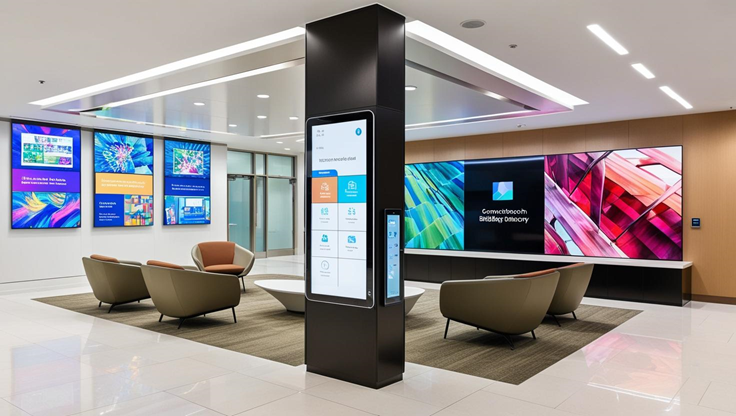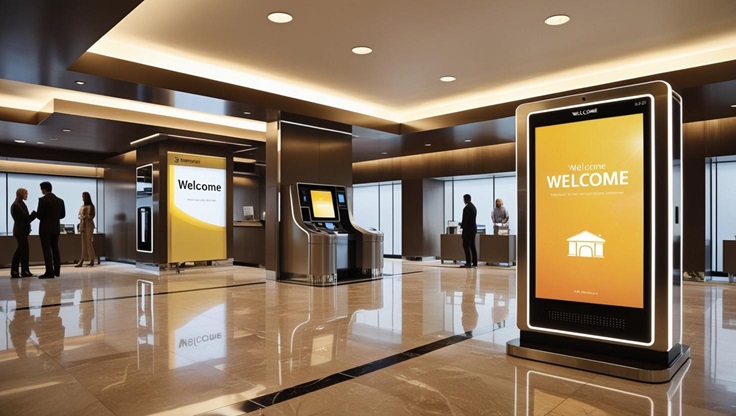1. Faster and More Efficient Wayfinding
One of the most significant advantages of interactive digital directories is their ability to streamline navigation. Instead of scanning a static list, visitors can quickly search for tenants, offices, or amenities using a touchscreen or mobile integration. Features like:
-
Real-time wayfinding maps – Display turn-by-turn directions inside the building.
-
Searchable directory listings – Find companies, departments, or individuals with ease.
-
Multiple language support – Assist international visitors with translations.
These tools reduce frustration, save time, and create a smooth arrival experience.
2. Enhanced Engagement and Interactivity
Unlike traditional directories, interactive digital directories create an engaging experience by allowing users to:
-
Tap, scroll, or voice-search for information.
-
Access additional details about tenants, such as business descriptions, hours, and contact details.
-
Scan QR codes to continue navigation on their mobile devices.
-
This interactive approach ensures visitors feel empowered and in control of their journey.

3. Real-Time Updates and Accuracy
A major drawback of static directories is that they become outdated as soon as a tenant moves in or out. Digital directories solve this issue by providing:
-
Instant updates – No need to reprint signs when tenant information changes.
-
Event and announcement integration – Showcase building-wide notices, promotions, and upcoming events.
-
Emergency messaging – Broadcast urgent alerts and safety information when needed.
This ensures that visitors always have access to the most current and relevant information.
4. A Modern, Professional First Impression
The look and feel of a building’s entrance set the tone for visitors, tenants, and clients. Interactive directories provide a sleek, high-tech, and professional experience, reinforcing the building’s brand identity and innovation. Features like:
-
Custom branding – Incorporate company logos, colors, and design elements.
-
Video and multimedia integration – Display welcome messages, news, or promotional content.
-
Smart touchless options – Gesture-based navigation or mobile interaction for a hygienic experience.
A well-designed digital directory creates a strong first impression while making navigation more intuitive.

5. Improved Accessibility for All Visitors
ADA-compliant digital directories ensure that all guests can access building information easily. They offer:
-
Voice guidance and text-to-speech options for visually impaired visitors.
-
Height-adjustable touchscreens for wheelchair users.
-
Multi-language support to assist international visitors.
By catering to diverse accessibility needs, digital directories create a welcoming environment for everyone.
6. Integration with Other Smart Building Systems
Modern buildings are becoming smarter, and digital directories play a key role in this transformation. They can integrate with:
-
Security and visitor check-in systems – Allow visitors to sign in digitally.
-
Transit and parking information – Display real-time transit schedules and available parking spaces.
-
Digital signage and advertising – Generate additional revenue by showcasing tenant promotions and advertisements.
This level of integration improves operational efficiency while enhancing the visitor’s experience.
The Key Takeaway
Interactive digital building directories are more than just a navigation tool—they enhance engagement, improve accessibility, and create a modern, welcoming environment for all visitors. By providing real-time updates, advanced wayfinding, and smart integrations, they transform how people interact with buildings, making every visit seamless and stress-free.
For buildings looking to elevate their visitor experience and efficiency, investing in interactive digital directories is a smart and future-proof solution.
Explore itouchinc.com for more information on our solutions or contact us for needs unique to your property or project.
|


